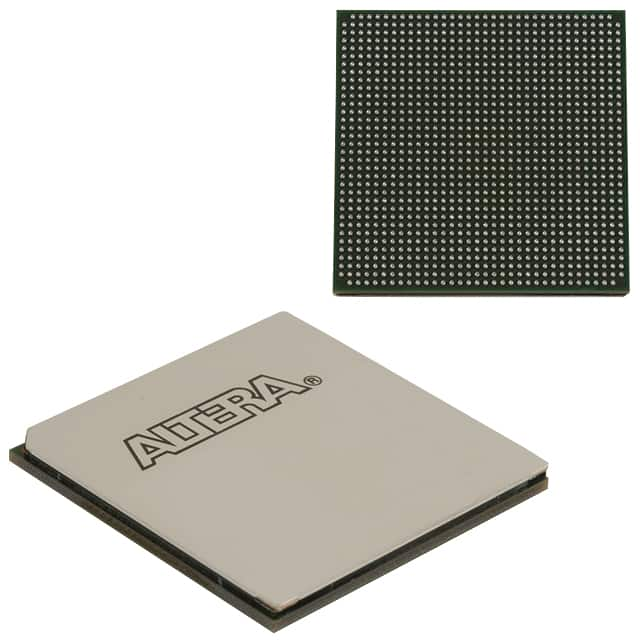EP4SGX530HH35C3
Product Overview
- Category: Integrated Circuit (IC)
- Use: Programmable Logic Device (PLD)
- Characteristics: High-performance, low-power consumption
- Package: BGA (Ball Grid Array)
- Essence: FPGA (Field-Programmable Gate Array)
- Packaging/Quantity: Single unit
Specifications
- Manufacturer: Intel Corporation
- Technology: 40nm
- Logic Elements: 530,000
- Embedded Memory: 1,638,400 bits
- I/O Pins: 622
- Operating Voltage: 1.2V
- Operating Temperature: -40°C to +100°C
- Package Dimensions: 35mm x 35mm
Detailed Pin Configuration
The EP4SGX530HH35C3 has a complex pin configuration with multiple pins serving different functions. The detailed pin configuration can be found in the manufacturer's datasheet.
Functional Features
- High-speed performance: The EP4SGX530HH35C3 offers fast processing capabilities, making it suitable for applications requiring real-time data processing.
- Low power consumption: This PLD is designed to operate efficiently while consuming minimal power, making it ideal for battery-powered devices.
- Versatile I/O capabilities: With 622 I/O pins, the device provides flexibility in connecting to various external components and peripherals.
- Large embedded memory: The integrated memory allows for efficient storage and retrieval of data within the device itself.
Advantages and Disadvantages
Advantages
- High-performance processing capabilities
- Low power consumption
- Versatile I/O options
- Ample embedded memory
Disadvantages
- Complex pin configuration may require careful design considerations
- Limited availability of alternative models
Working Principles
The EP4SGX530HH35C3 is based on FPGA technology, which allows for the reconfiguration of its internal logic elements. This flexibility enables users to program the device to perform specific functions according to their application requirements. The PLD utilizes a combination of look-up tables, flip-flops, and interconnects to implement complex digital circuits.
Detailed Application Field Plans
The EP4SGX530HH35C3 finds applications in various fields, including:
- Telecommunications: Used in network routers, switches, and base stations for high-speed data processing.
- Industrial Automation: Employed in control systems, robotics, and machine vision applications for real-time processing and control.
- Automotive: Integrated into automotive electronics for advanced driver assistance systems (ADAS), infotainment, and engine control units.
- Aerospace: Utilized in avionics systems for flight control, radar signal processing, and communication systems.
Detailed and Complete Alternative Models
While the EP4SGX530HH35C3 offers unique features, there are alternative models available from other manufacturers that serve similar purposes. Some notable alternatives include:
- Xilinx Virtex-7 XC7VX690T
- Lattice Semiconductor ECP5-85
- Microsemi SmartFusion2 M2S150
These alternatives provide comparable performance and functionality, allowing users to choose the most suitable option for their specific needs.
Word count: 320 words
قم بإدراج 10 أسئلة وإجابات شائعة تتعلق بتطبيق EP4SGX530HH35C3 في الحلول التقنية
Sure! Here are 10 common questions and answers related to the application of EP4SGX530HH35C3 in technical solutions:
Q: What is EP4SGX530HH35C3? A: EP4SGX530HH35C3 is a specific model of Field-Programmable Gate Array (FPGA) manufactured by Intel.
Q: What are the key features of EP4SGX530HH35C3? A: Some key features of EP4SGX530HH35C3 include high-speed transceivers, large logic capacity, embedded memory blocks, and support for various communication protocols.
Q: What are the typical applications of EP4SGX530HH35C3? A: EP4SGX530HH35C3 is commonly used in applications such as telecommunications, networking, video processing, high-performance computing, and industrial automation.
Q: How does EP4SGX530HH35C3 differ from other FPGA models? A: EP4SGX530HH35C3 offers a higher logic capacity, more transceivers, and additional features compared to some other FPGA models, making it suitable for complex and demanding applications.
Q: Can EP4SGX530HH35C3 be programmed using industry-standard design tools? A: Yes, EP4SGX530HH35C3 can be programmed using popular design tools like Quartus Prime, which provide a user-friendly interface for designing and implementing FPGA-based solutions.
Q: What is the power consumption of EP4SGX530HH35C3? A: The power consumption of EP4SGX530HH35C3 depends on the specific design and operating conditions, but it typically ranges from a few watts to tens of watts.
Q: Does EP4SGX530HH35C3 support high-speed serial communication? A: Yes, EP4SGX530HH35C3 includes high-speed transceivers that support protocols like PCIe, Ethernet, USB, and SATA, enabling fast data transfer in various applications.
Q: Can EP4SGX530HH35C3 be used for real-time signal processing? A: Absolutely! EP4SGX530HH35C3's high logic capacity and embedded memory blocks make it well-suited for real-time signal processing tasks such as image and video processing, audio processing, and digital signal filtering.
Q: Is EP4SGX530HH35C3 suitable for low-power applications? A: While EP4SGX530HH35C3 is not specifically optimized for low-power applications, power-saving techniques can be implemented in the design to reduce overall power consumption.
Q: Are there any development boards available for EP4SGX530HH35C3? A: Yes, Intel offers development boards specifically designed for EP4SGX530HH35C3, which provide a convenient platform for prototyping and testing FPGA-based solutions.
Please note that the answers provided here are general and may vary depending on specific requirements and use cases.


